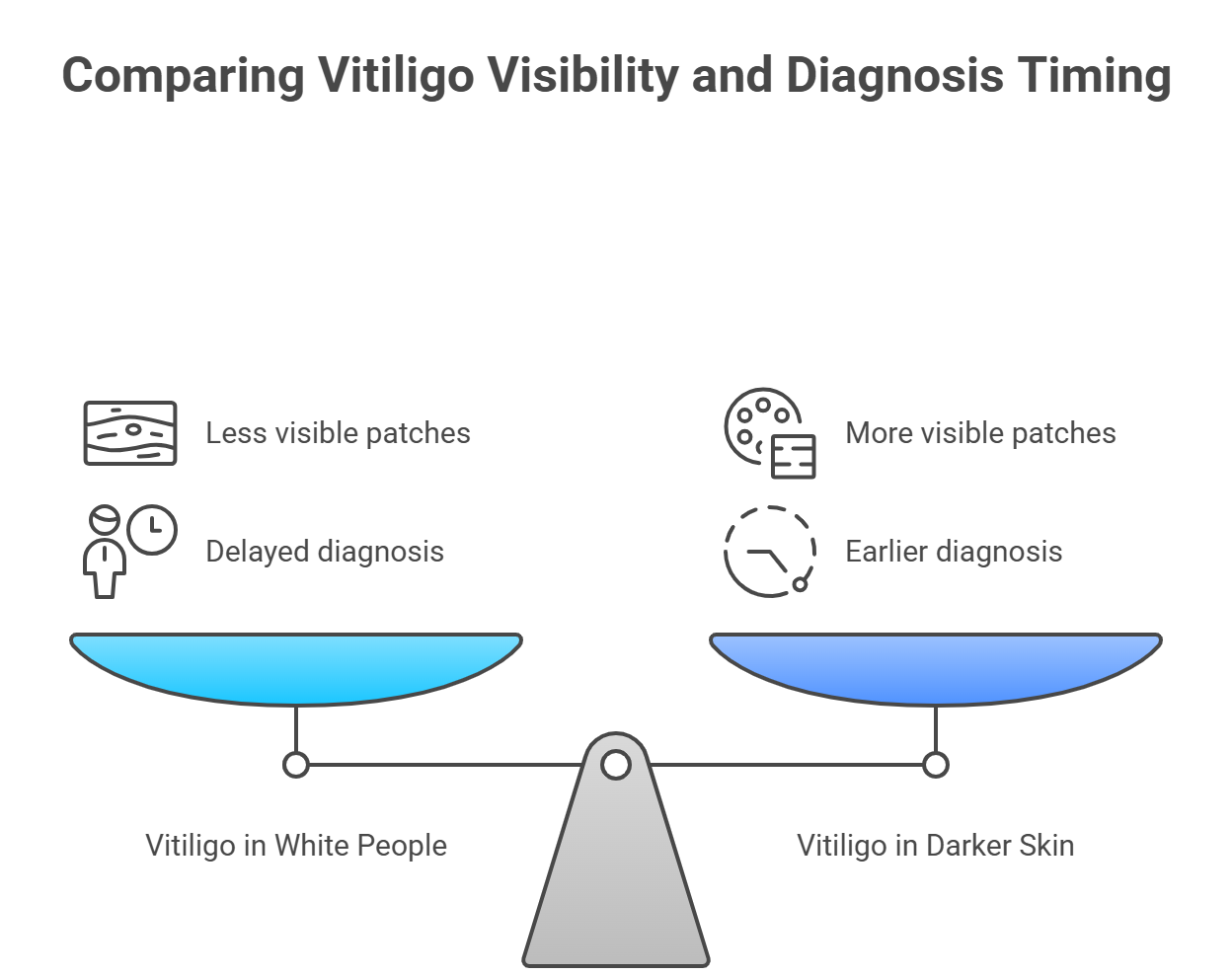Vitiligo Explained: Symptoms, Causes, and Myths

So, let's find out, what is vitiligo disease? Vitiligo is a long-term skin condition where patches of skin lose their pigment. Basically, the cells responsible for producing melanin, the stuff that gives our skin its color, stop doing their job or just vanish altogether. What you’re left with are white or lighter-colored patches that can show up almost anywhere on the body.
While it’s not painful or contagious, vitiligo often comes with a lot of emotional baggage. And that’s why understanding it is so important, not just for those who have it, but for everyone else too.
Types of Vitiligo
Now, not all vitiligo looks the same. There are actually a few types:
- Generalized Vitiligo – This is the most common type. The white patches show up on both sides of the body, kind of like a mirror image.
- Segmental Vitiligo – Here, the patches appear on just one side or in one specific area. It usually starts earlier and spreads less.
- Localized or Focal Vitiligo – Fewer patches that don’t spread much.
- Universal Vitiligo – Rare, but it affects almost the whole body.
Common Symptoms of Vitiligo
Skin Discoloration Patterns
The most obvious symptom? Yep, the white patches. They usually start small and grow over time. These patches commonly appear on:
- Hands
- Face (especially around eyes and mouth)
- Feet
- Genitals
- Underarms
- Knees and elbows
The pattern can vary widely. Some people get symmetrical patches, while others have them randomly placed.
Other Associated Changes
In some cases, people with vitiligo might also notice:
- Premature graying of hair (scalp, eyelashes, eyebrows, beard)
- Loss of color inside the mouth or nose
- Eye color changes (though this is rare)
This is all tied back to the same issue: melanin cells deciding to ghost your body.
How Do People Get Vitiligo?
You might be wondering: how do people get vitiligo if it’s not contagious? Great question.
Genetic Factors
First off, genetics play a big role. If someone in your family has vitiligo or another autoimmune condition, you’re a bit more likely to develop it. That doesn’t mean you will, but it does increase your chances.
Autoimmune Connections
This is a biggie. Vitiligo is widely believed to be an autoimmune condition. That means your immune system mistakenly attacks your own body , in this case, the pigment-producing cells. It’s like friendly fire in a very unhelpful war.
Often, people with vitiligo also have other autoimmune disorders like thyroid issues, alopecia areata, or lupus.
Environmental Triggers
Besides genes and autoimmunity, things like:
- Severe sunburn
- Skin injuries (cuts, scrapes)
- Emotional stress
- Exposure to certain chemicals
These can act as triggers. So, how do people get vitiligo? It's usually a mix of internal and external factors. Think of it as the perfect storm of biology and environment.
Popular Myths and Misconceptions About Vitiligo
Let’s bust some myths, shall we?
Contagion Myth
No , vitiligo is not contagious. You can’t catch it from touching someone, sharing food, or even kissing. The idea that it’s infectious is one of the most damaging and false myths out there.
Vitiligo and Hygiene
Some people think poor hygiene causes vitiligo. Wrong again. You can be squeaky clean or the world’s biggest neat freak and still develop vitiligo. It has nothing to do with cleanliness.
Only Affects Dark Skin?
Nope. Vitiligo affects all skin tones. It’s just more noticeable on darker skin due to the contrast in pigmentation. That visibility can also lead to more social stigma, which isn’t fair or based on science.
Vitiligo in white people: https://www.dailygram.com/blog/1328876/vitiligo-in-white-people-symptoms-causes-and-treatment-options/
Living with Vitiligo
Mental and Emotional Impact
Let’s get real, dealing with vitiligo can be emotionally tough. People might stare. Some make rude comments. It can affect confidence, self-esteem, even dating and relationships.
But here’s the thing: more people today are embracing their vitiligo. Social media has helped spread awareness and build support communities. Visibility matters.
Lifestyle and Skin Care Tips
Living with vitiligo doesn’t mean hiding indoors. Here are a few tips:
- Sun protection is key – Use broad-spectrum sunscreen. Those white patches burn easily.
- Gentle skincare – Avoid harsh products or scrubbing.
- Stay moisturized – Dry skin can make patches more visible.
- Watch your diet and stress levels – While food won’t cure it, a balanced lifestyle can help manage flare-ups.
Also, some people explore makeup or self-tanners for cosmetic blending. It’s totally a personal choice , no right or wrong.
Conclusion
Vitiligo isn’t just a skin condition , it’s a life experience. Whether you’re someone asking “what is vitiligo disease?” or wondering “how do people get vitiligo?”, the key is understanding. It’s not dangerous, not contagious, and definitely not something to be ashamed of. Awareness, empathy, and support can go a long way.
Let’s replace myths with facts, and stigma with compassion.
FAQs
- Is vitiligo curable?
No, vitiligo isn’t currently curable, but there are homeopathy treatments that can help manage symptoms of vitiligo or re-pigment skin to a degree. - Does vitiligo spread over time?
Yes, for many people, the patches can grow or new ones may appear. However, it varies greatly from person to person. - Can children get vitiligo?
Absolutely. Vitiligo can appear at any age, including during childhood. - Is vitiligo painful or itchy?
Usually, no. Most people don’t feel pain or itching in the affected areas, though sunburned patches can hurt more easily. - Can I prevent vitiligo if it runs in my family?
There’s no guaranteed prevention, but reducing skin trauma, managing stress, and protecting skin from harsh chemicals may help lower your risk.
- Art
- Causes
- Crafts
- Dance
- Drinks
- Film
- Fitness
- Food
- Games
- Gardening
- Health
- Home
- Literature
- Music
- Networking
- Other
- Party
- Religion
- Shopping
- Sports
- Theater
- Wellness


